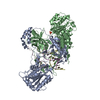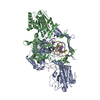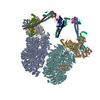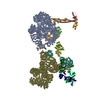+ Open data
Open data
- Basic information
Basic information
| Entry | Database: PDB / ID: 8bh3 | ||||||
|---|---|---|---|---|---|---|---|
| Title | DNA-PK Ku80 mediated dimer bound to PAXX | ||||||
 Components Components |
| ||||||
 Keywords Keywords |  DNA BINDING PROTEIN / DNA-PK / DNA BINDING PROTEIN / DNA-PK /  DNA-PKcs / DNA-PKcs /  Ku70 / Ku70 /  Ku80 / PAXX / Ku80 / PAXX /  NHEJ NHEJ | ||||||
| Function / homology |  Function and homology information Function and homology informationDNA ligation involved in DNA recombination / FHA domain binding / positive regulation of chromosome organization / positive regulation of ligase activity /  DNA ligase IV complex / DNA ligation involved in DNA repair / DNA ligase IV complex / DNA ligation involved in DNA repair /  DNA ligase activity / Ku70:Ku80 complex / DN2 thymocyte differentiation / negative regulation of t-circle formation ...DNA ligation involved in DNA recombination / FHA domain binding / positive regulation of chromosome organization / positive regulation of ligase activity / DNA ligase activity / Ku70:Ku80 complex / DN2 thymocyte differentiation / negative regulation of t-circle formation ...DNA ligation involved in DNA recombination / FHA domain binding / positive regulation of chromosome organization / positive regulation of ligase activity /  DNA ligase IV complex / DNA ligation involved in DNA repair / DNA ligase IV complex / DNA ligation involved in DNA repair /  DNA ligase activity / Ku70:Ku80 complex / DN2 thymocyte differentiation / negative regulation of t-circle formation / positive regulation of platelet formation / DNA ligase activity / Ku70:Ku80 complex / DN2 thymocyte differentiation / negative regulation of t-circle formation / positive regulation of platelet formation /  DNA ligase (ATP) / DNA ligase (ATP) /  DNA end binding / T cell receptor V(D)J recombination / pro-B cell differentiation / DNA end binding / T cell receptor V(D)J recombination / pro-B cell differentiation /  DNA ligase (ATP) activity / small-subunit processome assembly / positive regulation of lymphocyte differentiation / DNA-dependent protein kinase activity / histone H2AXS139 kinase activity / DNA-dependent protein kinase complex / immature B cell differentiation / nucleotide-excision repair, DNA gap filling / DNA-dependent protein kinase-DNA ligase 4 complex / single strand break repair / cellular response to X-ray / immunoglobulin V(D)J recombination / DNA ligase (ATP) activity / small-subunit processome assembly / positive regulation of lymphocyte differentiation / DNA-dependent protein kinase activity / histone H2AXS139 kinase activity / DNA-dependent protein kinase complex / immature B cell differentiation / nucleotide-excision repair, DNA gap filling / DNA-dependent protein kinase-DNA ligase 4 complex / single strand break repair / cellular response to X-ray / immunoglobulin V(D)J recombination /  nonhomologous end joining complex / protein localization to site of double-strand break / nonhomologous end joining complex / protein localization to site of double-strand break /  DNA ligation / nuclear telomere cap complex / regulation of smooth muscle cell proliferation / DNA ligation / nuclear telomere cap complex / regulation of smooth muscle cell proliferation /  V(D)J recombination / double-strand break repair via alternative nonhomologous end joining / V(D)J recombination / double-strand break repair via alternative nonhomologous end joining /  isotype switching / Cytosolic sensors of pathogen-associated DNA / double-strand break repair via classical nonhomologous end joining / regulation of epithelial cell proliferation / IRF3-mediated induction of type I IFN / telomere capping / isotype switching / Cytosolic sensors of pathogen-associated DNA / double-strand break repair via classical nonhomologous end joining / regulation of epithelial cell proliferation / IRF3-mediated induction of type I IFN / telomere capping /  recombinational repair / recombinational repair /  regulation of telomere maintenance / U3 snoRNA binding / regulation of hematopoietic stem cell differentiation / positive regulation of neurogenesis / protein localization to chromosome, telomeric region / cellular response to fatty acid / hematopoietic stem cell proliferation / cellular hyperosmotic salinity response / maturation of 5.8S rRNA / T cell lineage commitment / negative regulation of cGAS/STING signaling pathway / telomeric DNA binding / DNA biosynthetic process / positive regulation of catalytic activity / B cell lineage commitment / cellular response to lithium ion / 2-LTR circle formation / positive regulation of double-strand break repair via nonhomologous end joining / somatic stem cell population maintenance / site of DNA damage / regulation of telomere maintenance / U3 snoRNA binding / regulation of hematopoietic stem cell differentiation / positive regulation of neurogenesis / protein localization to chromosome, telomeric region / cellular response to fatty acid / hematopoietic stem cell proliferation / cellular hyperosmotic salinity response / maturation of 5.8S rRNA / T cell lineage commitment / negative regulation of cGAS/STING signaling pathway / telomeric DNA binding / DNA biosynthetic process / positive regulation of catalytic activity / B cell lineage commitment / cellular response to lithium ion / 2-LTR circle formation / positive regulation of double-strand break repair via nonhomologous end joining / somatic stem cell population maintenance / site of DNA damage /  ligase activity / ligase activity /  Lyases; Carbon-oxygen lyases; Other carbon-oxygen lyases / Lyases; Carbon-oxygen lyases; Other carbon-oxygen lyases /  enzyme activator activity / response to X-ray / 5'-deoxyribose-5-phosphate lyase activity / chromosome organization / hematopoietic stem cell differentiation / positive regulation of protein kinase activity / ectopic germ cell programmed cell death / ATP-dependent activity, acting on DNA / enzyme activator activity / response to X-ray / 5'-deoxyribose-5-phosphate lyase activity / chromosome organization / hematopoietic stem cell differentiation / positive regulation of protein kinase activity / ectopic germ cell programmed cell death / ATP-dependent activity, acting on DNA /  somitogenesis / somitogenesis /  DNA polymerase binding / SUMOylation of DNA damage response and repair proteins / condensed chromosome / positive regulation of telomerase activity / mitotic G1 DNA damage checkpoint signaling / positive regulation of telomere maintenance via telomerase / DNA polymerase binding / SUMOylation of DNA damage response and repair proteins / condensed chromosome / positive regulation of telomerase activity / mitotic G1 DNA damage checkpoint signaling / positive regulation of telomere maintenance via telomerase /  DNA helicase activity / activation of innate immune response / DNA helicase activity / activation of innate immune response /  telomere maintenance / cellular response to leukemia inhibitory factor / telomere maintenance / cellular response to leukemia inhibitory factor /  neurogenesis / neurogenesis /  cyclin binding / small-subunit processome / positive regulation of translation / positive regulation of erythrocyte differentiation / negative regulation of protein phosphorylation / cyclin binding / small-subunit processome / positive regulation of translation / positive regulation of erythrocyte differentiation / negative regulation of protein phosphorylation /  central nervous system development / stem cell proliferation / cellular response to ionizing radiation / central nervous system development / stem cell proliferation / cellular response to ionizing radiation /  protein-DNA complex / response to gamma radiation / Nonhomologous End-Joining (NHEJ) / protein-DNA complex / response to gamma radiation / Nonhomologous End-Joining (NHEJ) /  Hydrolases; Acting on acid anhydrides; Acting on acid anhydrides to facilitate cellular and subcellular movement / Hydrolases; Acting on acid anhydrides; Acting on acid anhydrides to facilitate cellular and subcellular movement /  brain development / peptidyl-threonine phosphorylation / protein destabilization / protein modification process / cellular response to gamma radiation brain development / peptidyl-threonine phosphorylation / protein destabilization / protein modification process / cellular response to gamma radiationSimilarity search - Function | ||||||
| Biological species |   Homo sapiens (human) Homo sapiens (human) | ||||||
| Method |  ELECTRON MICROSCOPY / ELECTRON MICROSCOPY /  single particle reconstruction / single particle reconstruction /  cryo EM / Resolution: 4.55 Å cryo EM / Resolution: 4.55 Å | ||||||
 Authors Authors | Hardwick, S.W. / Chaplin, A.K. | ||||||
| Funding support |  United Kingdom, 1items United Kingdom, 1items
| ||||||
 Citation Citation |  Journal: Sci Adv / Year: 2023 Journal: Sci Adv / Year: 2023Title: PAXX binding to the NHEJ machinery explains functional redundancy with XLF. Authors: Murielle Seif-El-Dahan / Antonia Kefala-Stavridi / Philippe Frit / Steven W Hardwick / Dima Y Chirgadze / Taiana Maia De Oliviera / Jessica Andreani / Sébastien Britton / Nadia Barboule / ...Authors: Murielle Seif-El-Dahan / Antonia Kefala-Stavridi / Philippe Frit / Steven W Hardwick / Dima Y Chirgadze / Taiana Maia De Oliviera / Jessica Andreani / Sébastien Britton / Nadia Barboule / Madeleine Bossaert / Arun Prasad Pandurangan / Katheryn Meek / Tom L Blundell / Virginie Ropars / Patrick Calsou / Jean-Baptiste Charbonnier / Amanda K Chaplin /    Abstract: Nonhomologous end joining is a critical mechanism that repairs DNA double-strand breaks in human cells. In this work, we address the structural and functional role of the accessory protein PAXX ...Nonhomologous end joining is a critical mechanism that repairs DNA double-strand breaks in human cells. In this work, we address the structural and functional role of the accessory protein PAXX [paralog of x-ray repair cross-complementing protein 4 (XRCC4) and XRCC4-like factor (XLF)] in this mechanism. Here, we report high-resolution cryo-electron microscopy (cryo-EM) and x-ray crystallography structures of the PAXX C-terminal Ku-binding motif bound to Ku70/80 and cryo-EM structures of PAXX bound to two alternate DNA-dependent protein kinase (DNA-PK) end-bridging dimers, mediated by either Ku80 or XLF. We identify residues critical for the Ku70/PAXX interaction in vitro and in cells. We demonstrate that PAXX and XLF can bind simultaneously to the Ku heterodimer and act as structural bridges in alternate forms of DNA-PK dimers. Last, we show that engagement of both proteins provides a complementary advantage for DNA end synapsis and end joining in cells. | ||||||
| History |
|
- Structure visualization
Structure visualization
| Structure viewer | Molecule:  Molmil Molmil Jmol/JSmol Jmol/JSmol |
|---|
- Downloads & links
Downloads & links
- Download
Download
| PDBx/mmCIF format |  8bh3.cif.gz 8bh3.cif.gz | 2 MB | Display |  PDBx/mmCIF format PDBx/mmCIF format |
|---|---|---|---|---|
| PDB format |  pdb8bh3.ent.gz pdb8bh3.ent.gz | 1.6 MB | Display |  PDB format PDB format |
| PDBx/mmJSON format |  8bh3.json.gz 8bh3.json.gz | Tree view |  PDBx/mmJSON format PDBx/mmJSON format | |
| Others |  Other downloads Other downloads |
-Validation report
| Arichive directory |  https://data.pdbj.org/pub/pdb/validation_reports/bh/8bh3 https://data.pdbj.org/pub/pdb/validation_reports/bh/8bh3 ftp://data.pdbj.org/pub/pdb/validation_reports/bh/8bh3 ftp://data.pdbj.org/pub/pdb/validation_reports/bh/8bh3 | HTTPS FTP |
|---|
-Related structure data
| Related structure data |  16044MC  7zwaC  7zygC  8ascC  8bhvC  8bhyC M: map data used to model this data C: citing same article ( |
|---|---|
| Similar structure data | Similarity search - Function & homology  F&H Search F&H Search |
- Links
Links
- Assembly
Assembly
| Deposited unit | 
|
|---|---|
| 1 |
|
- Components
Components
-Protein , 4 types, 10 molecules ASDMGHPQIR
| #1: Protein | Mass: 469673.219 Da / Num. of mol.: 2 / Source method: isolated from a natural source / Source: (natural)   Homo sapiens (human) Homo sapiens (human)References: UniProt: P78527,  non-specific serine/threonine protein kinase non-specific serine/threonine protein kinase#4: Protein | Mass: 21663.498 Da / Num. of mol.: 2 Source method: isolated from a genetically manipulated source Source: (gene. exp.)   Homo sapiens (human) / Gene: PAXX, C9orf142, XLS / Production host: Homo sapiens (human) / Gene: PAXX, C9orf142, XLS / Production host:   Escherichia coli BL21(DE3) (bacteria) / References: UniProt: Q9BUH6 Escherichia coli BL21(DE3) (bacteria) / References: UniProt: Q9BUH6#5: Protein |  / X-ray repair cross-complementing protein 4 / X-ray repair cross-complementing protein 4Mass: 38337.703 Da / Num. of mol.: 4 Source method: isolated from a genetically manipulated source Source: (gene. exp.)   Homo sapiens (human) / Gene: XRCC4 / Production host: Homo sapiens (human) / Gene: XRCC4 / Production host:   Escherichia coli BL21(DE3) (bacteria) / References: UniProt: Q13426 Escherichia coli BL21(DE3) (bacteria) / References: UniProt: Q13426#6: Protein |  / DNA ligase IV / Polydeoxyribonucleotide synthase [ATP] 4 / DNA ligase IV / Polydeoxyribonucleotide synthase [ATP] 4Mass: 104124.953 Da / Num. of mol.: 2 Source method: isolated from a genetically manipulated source Source: (gene. exp.)   Homo sapiens (human) / Gene: LIG4 / Production host: Homo sapiens (human) / Gene: LIG4 / Production host:   Escherichia coli BL21(DE3) (bacteria) / References: UniProt: P49917, Escherichia coli BL21(DE3) (bacteria) / References: UniProt: P49917,  DNA ligase (ATP) DNA ligase (ATP) |
|---|
-X-ray repair cross-complementing protein ... , 2 types, 4 molecules BTCL
| #2: Protein | Mass: 69945.039 Da / Num. of mol.: 2 Source method: isolated from a genetically manipulated source Source: (gene. exp.)   Homo sapiens (human) / Gene: XRCC6, G22P1 / Production host: Homo sapiens (human) / Gene: XRCC6, G22P1 / Production host:   Spodoptera frugiperda (fall armyworm) Spodoptera frugiperda (fall armyworm)References: UniProt: P12956,  Hydrolases; Acting on acid anhydrides; Acting on acid anhydrides to facilitate cellular and subcellular movement, Hydrolases; Acting on acid anhydrides; Acting on acid anhydrides to facilitate cellular and subcellular movement,  Lyases; Carbon-oxygen lyases; Other carbon-oxygen lyases Lyases; Carbon-oxygen lyases; Other carbon-oxygen lyases#3: Protein | Mass: 82812.438 Da / Num. of mol.: 2 Source method: isolated from a genetically manipulated source Source: (gene. exp.)   Homo sapiens (human) / Gene: XRCC5, G22P2 / Production host: Homo sapiens (human) / Gene: XRCC5, G22P2 / Production host:   Spodoptera frugiperda (fall armyworm) Spodoptera frugiperda (fall armyworm)References: UniProt: P13010,  Hydrolases; Acting on acid anhydrides; Acting on acid anhydrides to facilitate cellular and subcellular movement Hydrolases; Acting on acid anhydrides; Acting on acid anhydrides to facilitate cellular and subcellular movement |
|---|
-DNA chain , 4 types, 4 molecules jide
| #7: DNA chain | Mass: 7748.026 Da / Num. of mol.: 1 / Source method: obtained synthetically / Source: (synth.)   Homo sapiens (human) Homo sapiens (human) |
|---|---|
| #8: DNA chain | Mass: 8290.423 Da / Num. of mol.: 1 / Source method: obtained synthetically / Source: (synth.)   Homo sapiens (human) Homo sapiens (human) |
| #9: DNA chain | Mass: 8037.208 Da / Num. of mol.: 1 / Source method: obtained synthetically / Source: (synth.)   Homo sapiens (human) Homo sapiens (human) |
| #10: DNA chain | Mass: 8603.631 Da / Num. of mol.: 1 / Source method: obtained synthetically / Source: (synth.)   Homo sapiens (human) Homo sapiens (human) |
-Experimental details
-Experiment
| Experiment | Method:  ELECTRON MICROSCOPY ELECTRON MICROSCOPY |
|---|---|
| EM experiment | Aggregation state: PARTICLE / 3D reconstruction method:  single particle reconstruction single particle reconstruction |
- Sample preparation
Sample preparation
| Component | Name: NHEJ supercomplex bound to PAXX / Type: COMPLEX / Entity ID: all / Source: MULTIPLE SOURCES |
|---|---|
| Molecular weight | Value: 1.7 MDa / Experimental value: NO |
| Source (natural) | Organism:   Homo sapiens (human) Homo sapiens (human) |
| Source (recombinant) | Organism:   Spodoptera frugiperda (fall armyworm) Spodoptera frugiperda (fall armyworm) |
| Buffer solution | pH: 8 |
| Specimen | Conc.: 3 mg/ml / Embedding applied: NO / Shadowing applied: NO / Staining applied : NO / Vitrification applied : NO / Vitrification applied : YES : YES |
| Specimen support | Grid type: Quantifoil R1.2/1.3 |
Vitrification | Cryogen name: ETHANE |
- Electron microscopy imaging
Electron microscopy imaging
| Experimental equipment |  Model: Titan Krios / Image courtesy: FEI Company |
|---|---|
| Microscopy | Model: FEI TITAN KRIOS |
| Electron gun | Electron source : :  FIELD EMISSION GUN / Accelerating voltage: 300 kV / Illumination mode: FLOOD BEAM FIELD EMISSION GUN / Accelerating voltage: 300 kV / Illumination mode: FLOOD BEAM |
| Electron lens | Mode: BRIGHT FIELD Bright-field microscopy / Nominal magnification: 130000 X / Nominal defocus max: 2500 nm / Nominal defocus min: 800 nm / Cs Bright-field microscopy / Nominal magnification: 130000 X / Nominal defocus max: 2500 nm / Nominal defocus min: 800 nm / Cs : 2.7 mm / C2 aperture diameter: 50 µm : 2.7 mm / C2 aperture diameter: 50 µm |
| Specimen holder | Cryogen: NITROGEN / Specimen holder model: FEI TITAN KRIOS AUTOGRID HOLDER |
| Image recording | Electron dose: 52.1 e/Å2 / Film or detector model: GATAN K3 BIOQUANTUM (6k x 4k) |
- Processing
Processing
| Software |
| ||||||||||||||||||||||||||||||
|---|---|---|---|---|---|---|---|---|---|---|---|---|---|---|---|---|---|---|---|---|---|---|---|---|---|---|---|---|---|---|---|
| EM software |
| ||||||||||||||||||||||||||||||
CTF correction | Type: PHASE FLIPPING AND AMPLITUDE CORRECTION | ||||||||||||||||||||||||||||||
| Particle selection | Num. of particles selected: 327163 | ||||||||||||||||||||||||||||||
| Symmetry | Point symmetry : C1 (asymmetric) : C1 (asymmetric) | ||||||||||||||||||||||||||||||
3D reconstruction | Resolution: 4.55 Å / Resolution method: FSC 0.143 CUT-OFF / Num. of particles: 35211 / Symmetry type: POINT | ||||||||||||||||||||||||||||||
| Refinement | Cross valid method: NONE Stereochemistry target values: GeoStd + Monomer Library + CDL v1.2 | ||||||||||||||||||||||||||||||
| Displacement parameters | Biso mean: 707.18 Å2 | ||||||||||||||||||||||||||||||
| Refine LS restraints |
|
 Movie
Movie Controller
Controller







 PDBj
PDBj













































